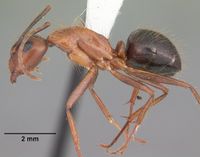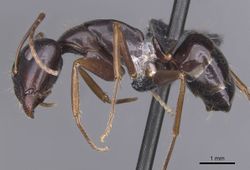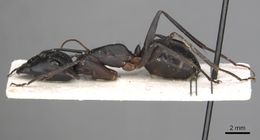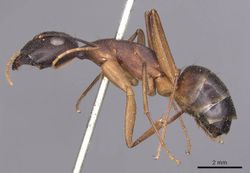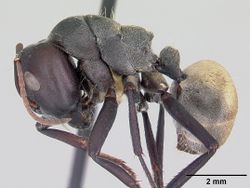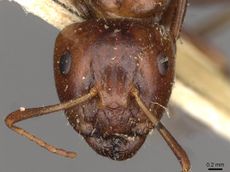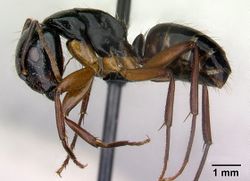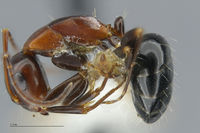Key to Camponotus of Israel
This key to major workers is based on: Ionescu-Hirsch, A. 2010 (2009). An annotated list of Camponotus of Israel, with a key and descriptions of new species. Israel Journal of Entomology. 39:57-98.
You may also be interested in
- Camponotus
- Israel (species list)
1
- Clypeus in full-face view with anterior margin projected beyond anterior margin of gena; anterolateral corner right angle (Figs. 15, 17, and 22) . . . . . 2
- Clypeus with anterior margin not extending beyond anterior margin of gena, broadly rounded (Fig. 18), or with anterolateral corner truncated (Fig. 21); if extending beyond anterior margin of gena, then free margin broadly emarginated medially (Fig. 16) . . . . . 17
2
return to couplet #1
- Scape and hindtibia covered with abundant suberect and erect setae; setae longer than scape and hindtibia diameter, longest setae more than twice as long as hindtibia diameter (Fig. 53) . . . . . Camponotus floridanus (this is a US species and is not believed to have established a population in Israel)
 Camponotus floridanus, Major |
- Erect setae on scape and hindtibia shorter and distinctly less abundant (Fig. 50), or lacking . . . . . Camponotus (Tanaemyrmex) . . . . . 3
3
return to couplet #2
- Body mainly yellow with at most, the last two gastral segments brownish; hind tibia tubular, without longitudinal ridge, oval in cross section . . . . . Camponotus turkestanus
- At least dorsum of last three gastral segments brown or black; if (rarely) body paler, hindtibia with distinct longitudinal ridge, prismatic (Fig. 54) . . . . . 4
4
return to couplet #3
- Gena with erect setae (Fig. 17) . . . . . 5
- Gena without erect setae (Fig. 15) . . . . . 9
5
return to couplet #4 Hind tibia with short apressed pubescence, without row of spiny bristles on ventral margin in addition to 3–4 suberect setae at distal end near spurs (Fig. 51); head and mesosoma usually light ferruginous-brown, sometimes head slightly darker . . . . . Camponotus jaliensis
- Hindtibia with at least one row of spiny bristles on ventral margin (Fig. 52); head dark brown to black . . . . . 6
6
return to couplet #5
- Hindtibia with erect setae on dorsal surface (Fig. 50); body matte . . . . . Camponotus festai
- Hindtibia without erect setae on dorsal surface; at least gaster shiny . . . . . 7
7
return to couplet #6
- Hind tibia flattened and with a distinct longitudinal ridge (Fig. 52); mesosoma black dorsally, yellow to brown ventrolaterally . . . . . Camponotus kefir
 Camponotus kefir, Major |
- Hind tibia without distinct longitudinal ridge; mesosoma monochromatic . . . . . 8
8
return to couplet #7
- Mesosoma with superficial sculpture laterally, entire ant shiny . . . . . Camponotus sannini
- Mesosoma with accentuated sculpture laterally, head and mesosoma dorsum matte in major workers . . . . . Camponotus aethiops
9
return to couplet #4
- Ventral head surface without erect setae . . . . . 10
- Ventral head surface with 1–10 erect setae (Fig. 12) . . . . . 12
10
return to couplet #9
- At least first gaster tergite yellow anteriorly and laterally . . . . . Camponotus sanctus (in part - also #15) (in part - also #16)
- Gaster uniformly dark brown or black . . . . . 11
11
return to couplet #10
- Petiole paler than first gaster segment; eye large, EL/HL = 0.23–0.26 (Fig. 11) . . . . . Camponotus xerxes
- Petiole concolorous with first gaster segment; eye small, EL/HL = 0.20–0.23 (Fig. 9) . . . . . Camponotus sinaiticus
12
return to couplet #9
- Hindtibia without row of bristles ventrally; clypeus slightly carinate, short (Fig. 22) . . . . . Camponotus carinifer
- Hindtibia with a row of bristles ventrally (Figs. 49 and 54); clypeus distinctly carinate, elongated (Fig. 15) . . . . . 13
13
return to couplet #12
- Mesosoma uniformly blackish-brown; leg uniformly yellow to ferruginous-yellow; head and mesosoma matte . . . . . Camponotus kugleri
- If mesosoma uniformly blackish-brown, than leg not uniformly colored, with femur partly infuscate or black; if leg uniformly pale, than mesosoma dorsum infuscate, and head and mesosoma sub-opaque or shiny . . . . . 14
14
return to couplet #13
- Hind tibia slightly compressed laterally, without distinct dorsomedial ridge (Fig. 49) . . . . . Camponotus baldaccii . . . . . Camponotus sp. near baldaccii
- Hindtibia prismatic, with distinct dorsomedial ridge (Fig. 54) . . . . . 15
15
return to couplet #14
- First gaster segment anteriorly and laterally, and second segment laterally, with distinctly paler areas, contrasting with dark color of rest of gaster; first and second tergites of gaster with anterolateral margins paler than middle in dorsal view . . . . . Camponotus sanctus (in part - also #10) (in part - also #16)
- Gaster uniformly dark, or with paler area(s) restricted to first segment; gaster entirely dark in dorsal view . . . . . 16
16
return to couplet #15
- Head and gaster of major worker entirely shiny to subopaque; minor worker shiny; bicoloured, bright black with mesosoma ventrally, petiole and macula on first gaster tergite brownish-red to yellow . . . . . Camponotus sanctus (in part - also #10) (in part - also #15)
- Major worker matte, sometimes with sub-opaque gaster; minor worker matte with gaster subopaque to shiny; mesosoma varies from black to faded reddish-brown . . . . . Camponotus fellah
17
return to couplet #1
- Propodeal dorsum broad and somewhat flat, margined laterally, in profile forming a distinct angle with the declivity (Figs. 24 and 30) . . . . . 18
- Propodeal dorsum narrow, transversally arched and not margined laterally, in profile forming an obtuse angle with the declivity (Fig. 48) . . . . . 27
18
return to couplet #17
- Propodeum posteriorly with obtuse teeth (Fig. 26); gaster covered with thick, apressed, golden mossy pubescence . . . . . Camponotus sericeus
- Propodeum unarmed (Fig. 25); if gaster with abundant, apressed pubescence, then pubescence white . . . . . 19
19
return to couplet #18
- Propodeum dorsum with erect setae over its surface (Figs. 31 and 36) . . . . . 20
- Propodeum dorsum only with a transverse row of erect setae along edge with declivity (Figs. 28 and 35) . . . . . 23
20
return to couplet #19
- Head and gaster black, mesosoma red . . . . . Camponotus interjectus
 Pheidole xxx, Major |
- Body uniformly dark brown to black . . . . . 21
21
return to couplet #20
- At least gaster shiny; head and mesosoma finely sculptured; gaster with sparse suberect setae and apressed pubescence . . . . . Camponotus gestroi
- Entire body matte; head and mesosoma coarsely sculptured; gaster minutely reticulate punctulate, covered with abundant suberect setae and apressed pubescence . . . . . Camponotus libanicus
23
return to couplet #19
- Clypeus smooth, with two lateral projections, anterior margin entire, not incised medially (Fig. 21); mesopropodeal suture not impressed (Fig. 46) . . . . . 24
- Clypeus subcarinate, with anterior margin incised medially (Fig. 20); mesosoma with impressed mesopropodeal suture (Figs. 28 and 38), rarely obsolete (Fig. 37) . . . . . 25
24
return to couplet #23
- Head and gaster blackish-brown or black; mesosoma and leg ferruginous-red to reddish-brown . . . . . Camponotus kurdistanicus
- Head, mesosoma and leg ferruginous-red to reddish-brown, gaster black; sometimes head brown dorsally . . . . . Camponotus vogti
25
return to couplet #23
- Propodeum dorsum convex longitudinally and transversally; mesopropodeal suture slightly impressed (Fig. 38) . . . . . Camponotus rebeccae
- Propodeum dorsum with posterior half concave longitudinally, rarely flat (Figs. 24 and 25); mesopropodeal suture strongly impressed (Fig. 28) . . . . . 26
26
return to couplet #25
- Head and gaster concolorous black; mesosoma (at least pronotum) red . . . . . Camponotus dalmaticus
- Head paler than gaster; mesosoma ochraceous . . . . . Camponotus lateralis
27
return to couplet #17
- Head circular in cross section, abruptly truncate in “soldier” (Fig. 13); worker: propodeum dorsum distinctly concave in lateral view (Fig. 45); petiole scale with acute summit in lateral view; dorsum indented in front view (Figs. 45 and 58) . . . . . Colobopsis truncata
- Head not circular in cross section and not abruptly truncated in any sub-caste (Fig. 14); other combination of characters . . . . . 28
28
return to couplet #27
- Propodeum dorsum concave in lateral view (Fig. 47); petiole scale thick with flat anterior and posterior surface, its contour in lateral view parallel lines converging at rounded summit (Fig. 47) . . . . . Camponotus sp. near vitiosus
- Propodeum dorsum usually straight or convex; if slightly concave in lateral view (Fig. 48), then petiole scale with anterior surface convex; posterior surface flat; summit sharp in lateral view (Fig. 48) . . . . . 29
29
return to couplet #28
- Gena with erect setae . . . . . 30
- Gena without erect setae . . . . . 31
30
return to couplet #29
- Scape with row of erect setae spread over its entire length (Fig. 23); body black, with coxae, femur, and first gaster segment anteriorly light reddish-brown; entire ant shiny . . . . . Camponotus tergestinus
- Scape without setae spread over its entire length; body brown to black; leg uniformly reddish-brown or black; head and mesosoma matte; gaster subopaque . . . . . Camponotus cilicicus
31
return to couplet #29
- Clypeus with short triangular impression anteromedially and wide notch in middle of anterior border; gaster shiny with sparse reduced pilosity; distance between hairlets larger than their length . . . . . Camponotus (Myrmentoma) (in part) . . . . . 32
- Free margin of clypeus truncated and impressed medially, without median notch; gaster dull, thickly covered with apressed pubescence; distance between hairlets smaller than their length . . . . . Camponotus. (Camponotus) (in part) . . . . . 33
32
return to couplet #31
- Body uniformly black with reddish antenna and tarsus; specimen from Caucasus with head anteriorly and mesosoma pale brown . . . . . Camponotus fallax
- Head and mesosoma red; gaster black . . . . . Camponotus sayi (this is a US species and is not believed to have established a population in Israel)
 Camponotus sayi, Major |
33
return to couplet #31
- Body completely black . . . . . Camponotus vagus
 Camponotus vagus, Major |
- Body mainly black, with funiculus, leg, and petiole brown . . . . . Camponotus pennsylvanicus (this is a US species and is not believed to have established a population in Israel)







